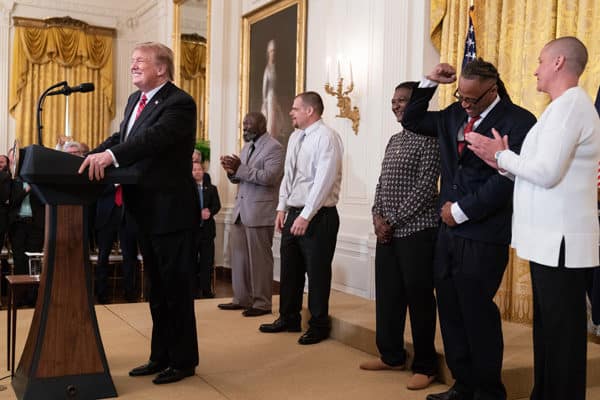Donald Trump Promised ‘Law and Order’
Bradley Moore, American Renaissance, June 27, 2019
Donald Trump proclaimed himself the “law and order” candidate in 2016. “[Y]ou can’t have true compassion without providing safety,” he said. “Without safety, you have nothing.”
Yet on May 26, 2019, President Donald Trump tweeted:
Anyone associated with the 1994 Crime Bill will not have a chance of being elected. In particular, African Americans will not be able to vote for you. I, on the other hand, was responsible for Criminal Justice Reform, which had tremendous support, & helped fix the bad 1994 Bill!
President Trump also called the bill a “dark period in American History” and condemned “Sleepy Joe Biden” for not apologizing.
The 1994 Violent Crime Control and Law Enforcement Act, the “1994 Crime Bill,” provided more funding for police officers and established the “three strikes” mandatory life sentence for repeat offenders. In late 2018, President Trump (with the help of his son-in-law Jared Kushner) pushed through the First Step Act, one of his few legislative accomplishments.
It reduces mandatory minimum sentences in some cases and increases “good time credits” for well-behaved prisoners. It also sets up a system that classifies an inmate’s risk and gives guidance on prisoner “housing, grouping, and program assignment.”
Van Jones, who famously termed the president’s 2016 victory a “whitelash,” said the legislation was a “Christmas miracle.” He understood that it symbolically repudiated the 1994 Crime Bill, which Mr. Jones and others think increased mass incarceration. He called it “historic” that President Trump and Joe Biden were competing on “who can be the best on criminal justice reform.”

President Donald Trump congratulates former inmates who have benefited from the passage of the First Step Act, April 1, 2019, in the East Room of the White House. (Credit Image: © SMG via ZUMA Wire)
Michelle Alexander, in her book The New Jim Crow, says jailing blacks isn’t about stopping crime but about “social and racial control.” In City-Journal in 2015, Heather MacDonald warned that this “discourse is going mainstream.”
It’s certainly mainstream; it’s seemingly shared by President Trump’s campaign manager Brad Parscale. He recently tweeted that the 1994 bill was a “TERRIBLE” mistake because it caused a “huge disparity in sentencing” and “mass incarceration of black men.” This view is echoed by Conservatism Inc. figures such as Turning Point USA’s Charlie Kirk.
Joe Biden:
Authored 1994 crime bill
Created mass incarceration issue in America
Life sentences for minor drug offenses
Wrote laws that disadvantaged African-Americans
Donald Trump:
Championed & passed criminal justice reform
One man made the mess, the other cleaned it up.
— Charlie Kirk (@charliekirk11) May 27, 2019
Bill Clinton signed the bill and Joe Biden said “Lock the S.O.B.’s up.” Yolanda Young, founder of On Being A Black Lawyer, wrote a 2016 piece called “Analysis: Black Leaders Supported Clinton’s Crime Bill.” “[I]t is clear black leaders were simply desperate to rid communities of the gang violence terrorizing their communities,” she said. “The crime wave was real with rapes, assaults, and murders at never before seen levels, especially in inner-cities.” The victims were, of course, black.
The real “dark period” was the early 1990s, when crime was at its worst. Americans took vicarious revenge on criminals at the movies. In his book, Wyatt Earp: The Life Behind the Legend, author Casey Tefertiller suggested that the 1993 film Tombstone spoke to a powerful subliminal desire for law enforcement to take the fight to the criminals.
Crime emerged as a social issue again in the America of the late 1980s and early 1990s, with debates focusing on the same issues that had torn Arizona apart a century earlier. America has never resolved one of the most fundamental questions of its legal system: In a nation of laws, should law reign supreme over public safety when the citizenry lives under constant threat? . . .
In the 1990s of drive-by shootings and gang warfare, the streets of some major cities became more dangerous than Tombstone ever was in the 1880s.
President Clinton even showed Boris Yeltsin the film to demonstrate American culture. It was in this climate that he signed the 1994 Crime Bill.
Lawmen did step up. In 1994, New York City Police Commissioner William Bratton, with the support of Mayor Rudy Giuliani, started the “broken windows” approach to policing. This meant aggressively combating neighborhood disorder, anti-social behavior, and minor crimes to reverse a climate of lawlessness. It also emphasized close attention to community concerns. Mr. Bratton writes in The Turnaround: How America’s Top Cop Reversed the Crime Epidemic:
We began to apply this concept to crime in the subways. Fare evasion was the biggest broken window in the transit system. We were going to fix that window and see to it that it didn’t get broken again. (p. 152)
The results: In 1990, there were 2,245 murders. By 1996, there were fewer than a thousand. The New York Times wrote an article called, “New York Crime Rate Plummets To Levels Not Seen In 30 Years.”
Yet in 2015, Bill Clinton apologized to the NAACP for the 1994 Crime Bill, saying it had made things “worse.” Donald Trump apparently agrees with him. They have both forgotten what crime was like in the early 1990s, or they don’t care.
For President Trump, black criminals are more important than public safety. He’s soft on crime and has broken another promise. Worse, with George Soros-backed progressive district attorneys winning elections, we’re likely to see a lot more “broken windows” in the future — and a lot more crime.















